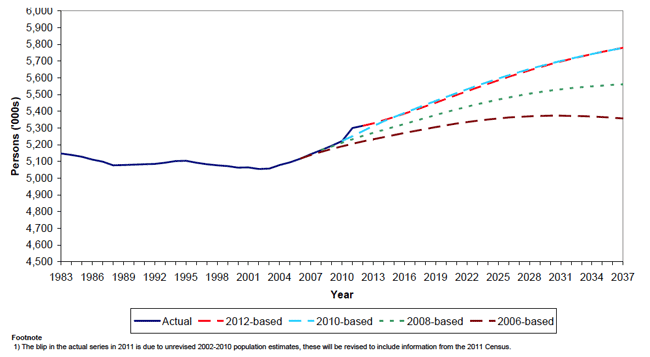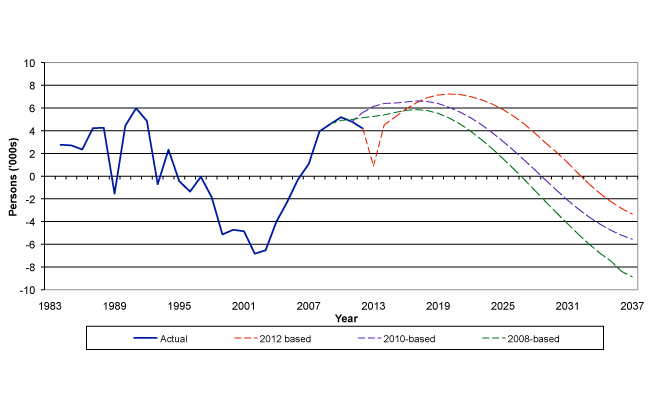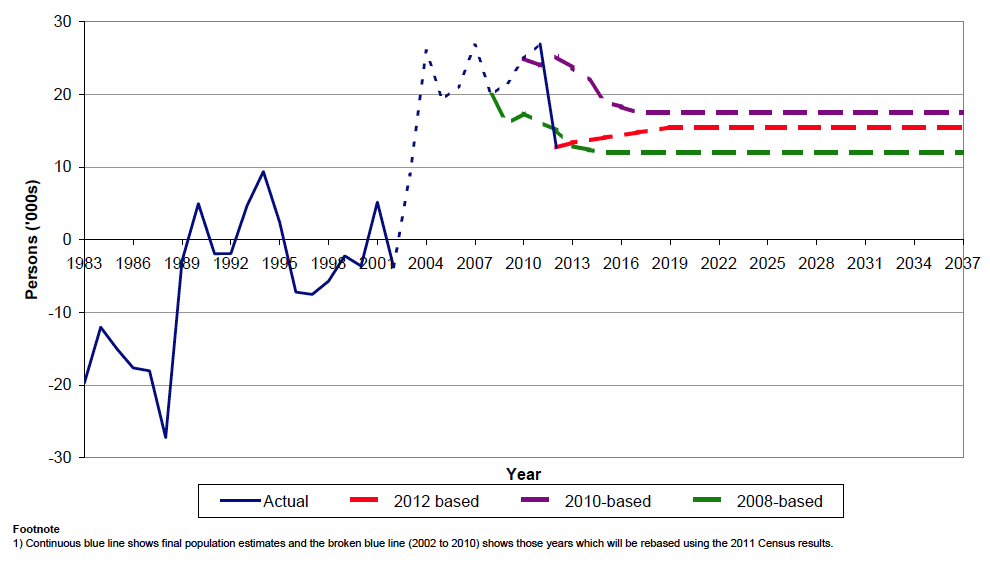
5.1. The last set of projections, published in October 2011, were based on the mid-year population estimates for 2010. These projections did not incorporate the 2011 Census results. Previous projections were based on the mid-2010 population estimates, and the mid-2008 population estimates. The key changes from previously published projections in terms of births, deaths and total population are shown in Table 5a, Table 5b and Table 5c respectively. Section 5.5 looks at the differences in the migration assumptions between the projections.
5.2. Figure 10 compares the 2012-based projection with previous projections. These latest projections, based on the population estimate for mid-2012, are broadly in line with our last projections (based on 2010 data). However there have been some underlying demographic changes to note. In the intervening two years, the birth rate has remained relatively high and there has been a decrease in net migration. We also rebased our population estimates for 2011 and 2012 with information from the 2011 Census which meant that the base population used in the projections was higher by about 49,000 to what we had previously estimated. So while the overall population projection total for the next 25 year period is very similar to that projected for the 2010 based projections, the underlying demographic trends differ and the base population has taken into account information from the 2011 Census. More information on the differences between the rolled forward estimates from 2001 for 2011 and the 2011 Census are available in the 2011 Census Reconciliation Report on the NRS website. Looking further ahead, the population is projected to rise continually until 2110 in line with the 2010 based projection, whereas the 2008-based and 2006-based projections all showed the population declining at some stage during the projection period.
Figure 10: Actual1 and projected total population compared with previous projections, 1983-2037

5.3. Figure 11 compares the natural change (the difference between the number of births and deaths) underlying the 2012-based projection with that underlying previous projections. Looking at the first 25 years of the projection period and comparing with the 2010-based projections, the number of births is projected to be higher (by an average of around 700 per year) and the number of deaths also slightly lower (by an average of around 900 per year). As a result there is a higher natural increase for the 2012-based projections from 2017 onwards. More information on the reasons for the differences is given in Section 4 and in Annex A, Annex B and Annex C.
5.4. The births and deaths for the first year of the projection period (2013) are based on the trends on the years leading up to the base year (2012) which are then controlled to the latest available mid-year data. In this projection there is a noticeable increase in the number of deaths for 2013 due to controlling the figures to the provisional 2013 figures available at the time the projection was run.
Figure 11: Actual and projected natural change (births minus deaths) compared with previous projections, 1984-2037

5.5. As Figure 12 demonstrates, the long-term migration assumption has been decreased from +17,500 in the 2010-based projections to +15,500. This change reflects the most recent trends in international migration and in cross-border migration to Scotland. New methods have been used to model migration trends in setting the migration assumptions for the 2012 based projections, more information can be found on the ONS website. The migration variants in Section 8 show what would happen to the population under various different levels of migration.
Figure 12: Actual1 and projected net migration compared with previous projections, 1983-2037

5.6. Table A and Table B below summarise the differences between the 2012-based and the 2010-based projections. The difference in results for the projected age structure of Scotland is fairly small. There is a slightly higher percentage of children in the 2037 population. Working age is projected to make up a slightly smaller percentage of the population in 2037 (both differences of about 1 percentage point). As a result the projected number of dependents per 100 of working age in 2037 are higher for the 2012-based projections than in the 2010-based projections.
Table A: Projected age structure of Scotland's population (percentage of total population)
| Age Group | 2010-based | 2012-based | ||
|---|---|---|---|---|
| 2012 | 2037 | 2012 | 2037 | |
| Children | 17% | 16% | 17% | 17% |
| Pension age | 20% | 23% | 20% | 23% |
| Working age | 63% | 61% | 63% | 60% |
Table B: Projected number of dependents per 100 population of working age, Scotland
| Age Group | 2010-based | 2012-based | ||
|---|---|---|---|---|
| 2012 | 2037 | 2012 | 2037 | |
| Children | 28 | 27 | 27 | 28 |
| Pensioners | 32 | 38 | 31 | 38 |
| All dependents | 59 | 64 | 59 | 66 |